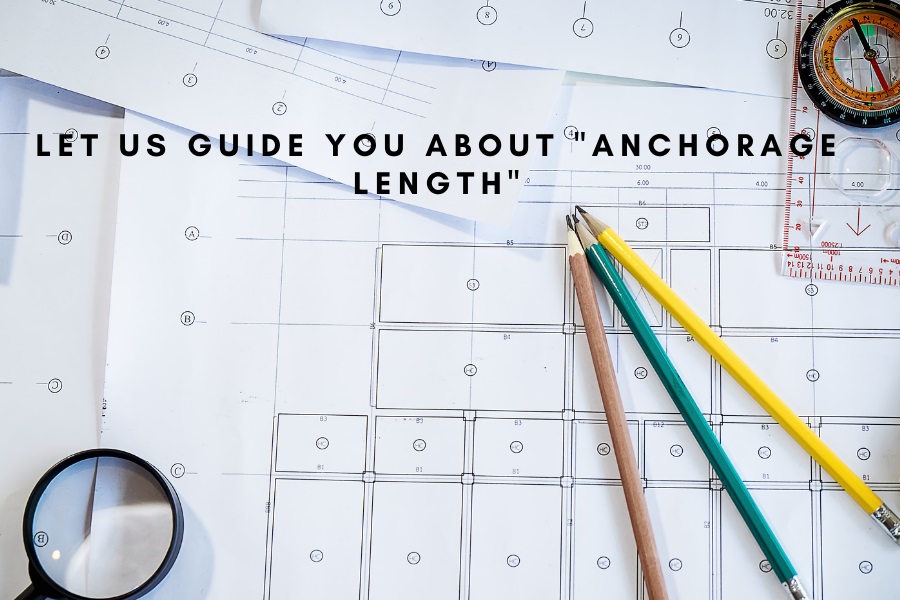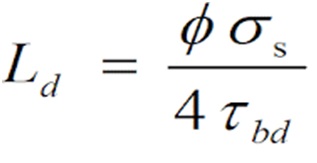Let Us Guide You About “Anchorage Length”

Technology is at its immense rise. This rise of technology has resulted in demand for more. Civil engineering has been one of a top-rated branch of engineering has to fulfill all those demands and needs. For this, heavy infrastructures are required for fulfilling all those essential needs. The core behind this rapid rise of technology is the rise of population. In simple terms, we can say that the rapid rise of technology is directly proportional to the increase in population. More the population, more will be advanced technology. The reason behind this is the innovation mind by more number of engineers around the world.
Since the demand for infrastructure is the prime concern of every governmental body. To undertake the issue, civil engineers play a key role in getting things right in perfect order.
Let’s ask ourselves a question. To design any infrastructure or building, what all things a common man is looking for. The answer is quite simple. Safety, Strength, and durability. To enhance strength lot of core conceptual concepts comes into play which we will discuss in detail but overall the prime concept lies in the fact that under severe circumstances, the building should not collapse. To enhance the strength to the safety level, a lot of minor modifications are been done to the infrastructure. The basic concept is quite long. Here an important term comes into play which is called “Anchorage Length”. Anchorage length is merely two words but sums up the whole story concerningonl safety in civil engineering. More strength ensures safety which anchor length provides.
When the ship or vessel container is parked in the sea for any reason, a large chain is grounded and then gets attached to the sea bed through its deep penetration enabling the ship to stay firm and unmovable. The penetration on the sea bed is done through a metallic structure known as an anchor. I hope now you have got a little bit of idea about the work of an anchor. But while we relate this term to civil engineering. It’s the beam or bar that needs to be standing firm with its mating structure.
When a beam is attached to its member, it’s not only the concrete that bonds two mating members. Some length of that beam is penetrated deep inside to provide resistance against various stresses acting. Stress is Load upon the area. The SI unit of stress is N/mm2. Though many types of stresses are been acting all at once two major types of stresses are tensile stress and compressive stress under which the whole concept of anchorage length works.
The extra bit of beam that is penetrated deep inside, its length is known as Development Length (Ld). But in many cases, to provide extra resistance to the beam for compressive and tensile stresses, a bend is provided. The length of that extra bend by utilizing the development length is known as anchorage length.
Anchorage length concept is quite long but here we shall be discussing the basic concepts which are helpful for every civil engineer in a long run. The full concept can easily be studied through an online platform known as the civil era. Apart from all these, online civil engineering software courses are also provided on our website.

Anchorage length is of two types one is the bend that we generally do and the second one is the hook applicable for mild steel beams. The hook is the bend done through the primary bend in the shape of U. To calculate anchorage length, the development length is denoted by Ld.
Where Ld is the development length.
Φ is the nominal diameter of the bar
4 τbd is designed to bond stress while
σ is the stress in a bar in a section
Through the above equation, we can easily calculate the development length. Now to calculate anchorage length we need to keep certain points in mind. They are:-
- In a bend, it’s 4 times the nominal diameter of the bar. For 90 degree bend, it’s eight times while 6 times for 135-degree bend and 4 times for 180-degree bend.
- For hook, it’s 4X (4) which is 16 times the diameter.
Considering these two points in mind, we can easily find out the anchorage length. It depends on the types of load acting whether to point the direction of anchor to up or down. But generally, it’s in the upper direction, the reason being that it provides more resistance to the bar been stressed downwards.
Now as we are familiar with the anchorage length and the way to calculate it. Now we shall be knowing the factors which affect anchorage length. Here basic ones are listed below:-
- The density of concrete- The density of the concrete matters a lot as more strength will be ensured through high density and vice-versa.
- Rebar clear cover- Clear cover is the extra material been provided on rebar to enhance strength and durability.
- Rebar diameter- the more the diameter, the more will be the strength as enhanced resistance against the stress through it.
Summarising the whole content in few lines, I just want to write that deep analysis of penetrated beam or bar is must calculate its length to increase its strength and avoiding any kind of slips that can suddenly result in accidents. The study of a development length and anchorage length is very important for each aspirant. The civil era has evolved as the perfect platform for each aspirant to learn the basic concept at a reasonable price. Time and tide wait for none. Let us not waste time by investing in learning the key concepts of civil engineering from the civil era.